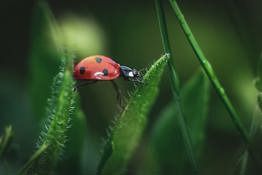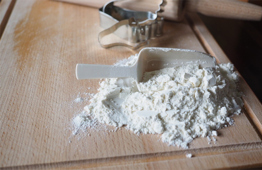Eating figs in Israel: Guide for the Perplexed

This article discusses figs, different forms of pollination, and common infestation issues.
Foreword
In this short article we will take a look at the fig and various insect-related issues. Specifically: the female and male fruit, wasps, parthenocarpic fig trees, Mediterranean fruit fly larvae, beetle larvae, and thrips.
1. Wasps that pollinate figs
The fig (Ficus carica) belongs to the berry family (Moraceae). The fig tree is dioecious, that is, there are separate male trees that bear male flowers, and female trees with female flowers. The male tree, termed the caprificus (or wild fig), also has short-styled pistillate female flowers that do not develop into edible fruit. However, these flowers play an important role in the pollination process, as they provide a home for wasps. The female trees have only female long styled pistillate flowers, which ripen into fruit and seeds.
The fig as we know it is an inverted flower of sorts (imagine a flower that is turned inside-out, like a sock). The fig tree's reproductive organs are inside the fruit. For wasps to transfer pollen from a male to a female flower, it first needs to reach the flowers. This is where the opening at the end of fig (ostiole), that we are all familiar with, comes into the picture: the female wasps climbs through the opening to reach the flowers. In the process of creeping through the narrow passage, it often loses its wings and part of its antennas.
The fig is pollinated by the Blostophaga psenes wasp, a small insect some 2 mm long, which is unique to fig trees. These wasps breed in the caprificus figs. The unripe fig on the caprificus is a receptacle that includes short-stemmed female flowers at the center with male flowers adjacent to the opening at the exit of the fig. The wasps develop in the female fig flowers. The male wasps pollinate the female flowers before emerging from the gall, created in the female flower, and with that their role is complete. The female wasps break through the gall in which they developed after being fertilized, carry lots of pollen on their way out of the male flowers, and take off to find male fig trees to lay their eggs. Some inadvertently reach female fig trees and penetrate the unripe fruit to lay their eggs. As part of their egg-laying efforts, they also pollinate the flowers, which makes it possible for them to ripen into fruit and for the seeds to develop.
The wasps cannot lay their eggs on the unripe fruit of the female trees, since they cannot penetrate the long flowers.
Of the fig trees that grow in Central and Northern Israel (generally smirniaca and bursa varieties), 50%-60% of the unripe figs are pollinated by wasps. It is possible to identify a pollinated fruit by cutting it in half. If there is no hole at the center of the fruit, it is pollinated. Figs pollinated by wasps are marked by being especially sweet and weigh more than their unfertilized counterparts. Generally, wasps enter the fig when it is still green, two months before harvest. The sap of the fruit is called latex, and it dissolves the wasps; thereafter its carcass is no longer detectable.
Fertilized figs have fewer thrips, since they have no room to move about inside the fig. The black fig fly also avoids laying eggs on figs pollinated by wasps.
Rabbi Yehuda Amichay ("Eating pollinated figs," Emunat Itecha 20, 5758) explains that it is permissible to eat figs, as the Torah includes the fig in the list of the seven species. It is not plausible that G-d would praise the Land of Israel by mentioning a forbidden fruit. However, one should keep reading until the end of the article to know how to take proper preventative measures to be able to eat the fruit without accidentally eating insects.
We eat the fruit of the female fig trees, where the wasps do not survive. Only in the male fig trees do wasps penetrate the fruit, lay eggs, and raise the next generation of wasps. Today, a significant amount of figs sold on the market are propagated by self-pollination (parthenocarpy), without wasps. However, if we pick figs directly from a tree (and there are plenty of fig trees growing throughout Israel), there is a possibility that a wasp accidentally entered it. While it didn't lay eggs inside the fig, it perished in the fruit and thereafter broke down into protein. During the ripening process, the fig 'digests' the entire wasp, as it were, by excreting ficin, an enzyme that breaks down the carcass into protein. In this way the wasp becomes an integral part of the fruit, and we cannot detect it.
When the wasp initially enters the fig, it has the halachic status of beriya, an organism, which is not nullified in a mixture (Shulchan Aruch YD 100:1). However, in light of what we explained above, the wasp later becomes nullified to the fruit to the point that it breaks down into protein. For this reason, it seems that there is no need for concern with regard to eating pollinated figs, as Rabbi Yehuda Amichay rules.
2. Common insects inside figs
In Israel, most fresh figs on the market are grown without wasp intervention, yet there is still a concern regarding the presence of other insects. For this reason, those who prefer not to eat insects due to kashrut or lifestyle reasons (vegetarians and vegans) should closely examine figs before eating them.
Brazilian figs exported to Europe have relatively high thrip infestation rates. This necessitates appropriate pesticides to ensure a fruit free of such insects. The Nazareth variety, though has the lowest rate of thrip infestation.
- Thrips and beetles present the primary kashrut problem in commercially grown orchards. Thrips penetrate the unripe fig and cause the flowers to brown; brown-rust flowers indicate the presence of thrips in the fruit. Figs harvested in the early ripening stage, when the fruit is still tough and inedible (termed bochal by the Mishna) will be free of beetles and Mediterranean fly larvae. On the other hand, overripe fruit left on the tree can be infested with these pests. The Mediterranean fly does not present a kashrut problem for commercial figs, but often its larvae contaminate wild fig trees, since the fruit is harvested when ripe—when the fruit is susceptible to the fly's stings.
- Baladi figs, which are not grown for export, are rarely infested by thrips.
- Orchards with figs grown for export treat the trees with pesticides that meet European Union and Israeli standards to ensure insect-free fruit without pesticide traces. Covering orchards with thick netting also prevents pest penetration and makes it possible to produce insect-free fruit.
- Dried figs imported from abroad are often infested by beetle and moth larvae. While the sterilization process might kill these insects, it does not rid the fruit of them.
For the article with footnotes (Hebrew), see here.




